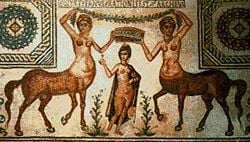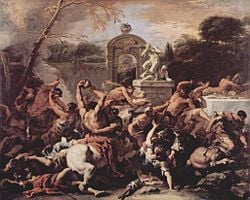Centaur
In Greek mythology, the centaurs (Greek: Κένταυροι) are a race of creatures half human and half horse. This human and animal combination has lead many writers to treat them as liminal beings, caught between the two natures of feral animality and wise humanity.
Etymology
The Greek word kentauros could be etymologized as ken - tauros, which means "piercing bull". Another possible etymology can be "bulls slayer". Some say that the Greeks took the constellation of Centaurus, and also its name "piercing bull", from Mesopotamia, where it symbolized the god Baal who represents rain and fertility, fighting and piercing with his horns the demon Mot who represents the summer drought. (In Greece, Mot became the constellation of Lupus.) Later in Greece, the constellation of Centaurus was reinterpreted as a man riding a horse, and linked to legends of tribes from Thessaly horsemen from the north. [1] The idea of a combined monster may have arisen as an attempt to fit the pictorial figure to the stars better.
Origin
The most common theory holds that the idea of centaurs came from the first reaction of a non-riding culture, as in the Minoan Aegean world, to nomads who were mounted on horses. The theory goes that such riders would appear as half-man, half-animal. (Bernal Díaz del Castillo reported that the Aztecs had this misapprehension about Spanish cavalrymen.)[2] Horse taming and horseback culture evolved first in the southern steppe grasslands of Central Asia, perhaps approximately in modern Kazakhstan.
The Lapith tribe of Thessaly, who were the kinsmen of the Centaurs in myth, were described as the inventors of horse-back riding by Greek writers. The Thessalians tribes also claimed their horse breeds were descended from the centaurs.
Of the various Classical Greek authors who mentioned centaurs, Pindar was the first who describes undoubtedly a combined monster. Previous authors (Homer etc) only use words such as Pheres (Beasts) that could also mean ordinary savage men riding ordinary horses. However, contemporaneous representations of hybrid centaurs can be found in archaic Greek art.
Centauromachy
The Centaurs are best known for their fight with the Lapithae, caused by their attempt to carry off Hippodamia, and the rest of the Lapith women, on the day of her marriage to Pirithous, king of the Lapithae, himself the son of Ixion. The strife among these cousins is a metaphor for the conflict between the lower appetites and civilized behavior in humankind. Theseus, who happened to be present, a hero and founder of cities, threw the balance in favor of the right order of things, and assisted Pirithous. The Centaurs were driven off or destroyed.[3][4][5]. Another Lapith hero, Caeneus, who was invulnerable to weapons, was beaten into the earth by Centaurs wielding rocks and the branches of trees.
Like the Titanomachy, the defeat of the Titans by the Olympian gods, the contests with the Centaurs typify the struggle between civilization and barbarism.
Vignettes of the battle between Lapiths and Centaurs were sculpted in bas-relief on the frieze of the Parthenon, which was dedicated to wise Athena. The battle with the Lapithae, and the adventure of Heracles with Pholus[6] are favourite subjects of Greek art.[7]

The mythological episode of the centaur Nessus carrying off Deianira, the bride of Heracles, also provided Giambologna (1529-1608), a Flemish sculptor whose career was spent in Italy, splendid opportunities to devise compositions with two forms in violent interaction. He made several versions of Nessus carrying off Deianira, represented by examples in the Louvre, the Grünes Gewölbe, Dresden, the Frick Collection, New York and the Huntington Library, San Marino, California. His followers, like Adriaen de Vries and Pietro Tacca, continued to make countless repetitions of the subject. When Carrier-Belleuse tackled the same play of forms in the 19th century he titled it Abduction of Hippodameia .
Centaurs in fiction
Centaurs have appeared many times and in many places in modern times, in for example Artemis Fowl, Avatar's Perdition: Black Sword Chronicle, Fantasia, the Narnia books (as well as in the movie adaptation of its first novel, The Chronicles of Narnia: The Lion, the Witch and the Wardrobe), Hercules: The Legendary Journeys, The Golden Voyage of Sinbad, Xena: Warrior Princess, Harry Potter, Clash of the Titans and the trilogy Titan, Wizard, Demon and they also featured prominently in the Xanth series. Additionally, the Centaur Inn was the hotel in Shakespeare's The Comedy of Errors.
ReferencesISBN links support NWE through referral fees
- ↑ "Centaur" The Compact Edition of The Pxford English Dictionary. Oxford Univ.Press, Oxford: 1971
- ↑ Stuart Chase, Mexico: A Study of Two Americas, Chapter IV (University of Virginia Hypertext), accessed 24 April 2006.
- ↑ Plutarch, Theseus, 30
- ↑ Ovid, Metamorphoses xii. 210
- ↑ Diodorus Siculusiv. 69, 70
- ↑ Apollodorus, ii. 5; Diod. Sic. IV, li
- ↑ see Sidney Colvin, Journal of Hellenic Studies, I, 1881, and the exhaustive article in Roscher's Ausführliches Lexikon der griechischen und römischen Mythologie
External links
- Theoi Project on Centaurs in literature
- "MythWeb" article on centaurs
Credits
New World Encyclopedia writers and editors rewrote and completed the Wikipedia article in accordance with New World Encyclopedia standards. This article abides by terms of the Creative Commons CC-by-sa 3.0 License (CC-by-sa), which may be used and disseminated with proper attribution. Credit is due under the terms of this license that can reference both the New World Encyclopedia contributors and the selfless volunteer contributors of the Wikimedia Foundation. To cite this article click here for a list of acceptable citing formats.The history of earlier contributions by wikipedians is accessible to researchers here:
The history of this article since it was imported to New World Encyclopedia:
Note: Some restrictions may apply to use of individual images which are separately licensed.
